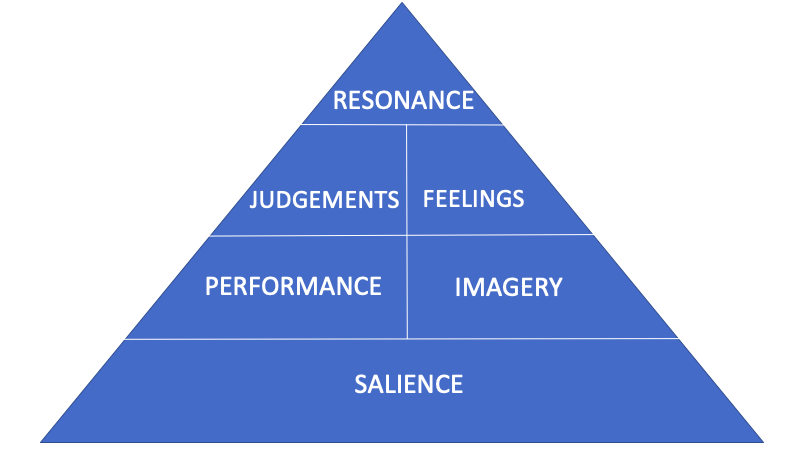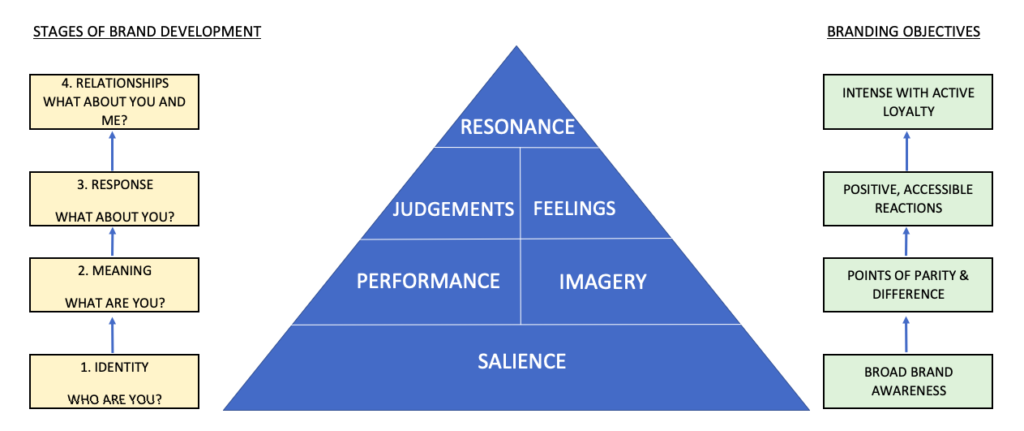
In this article, we are going to take a look at the Brand Resonance Pyramid.
There is a clear need, within business, to understand how the mechanics of branding work so that we can position our business strategies accordingly, driving customers and revenues.
We want our brand to be front and center. We want it to be considered by our customers in not only buying situations but also in terms of a long term mutually beneficial relationship.
This drives security, growth and market share.
There are various influencing factors in getting our brand/product to that position. Understanding those influences can help arm us in building marketing and product strategies.
The Brand Resonance Pyramid helps us visualize these steps and building blocks that are required to build a successful and emotional bond between the customer to the brand/product.
What is the Brand Resonance Pyramid?
The Brand Resonance Pyramid is a graphical depiction of the brand relationship, focusing on the various building blocks within the customer experience and culminating with the ultimate goal of brand resonance.
The Pyramid features within Keller’s Brand Equity Model (also known as Customer-Based Brand Equity). The model depicts the equity required to communicate to, retain and ultimately build relationships with customers.
It is based on the belief that a brands power is derived by four key customer attributes
- What they have heard,
- What they have learned,
- What they have felt and
- What they have seen.
Why Brand Resonance?
The pinnacle of the brand resonance pyramid is resonance. A strong brand relies on a range of facets — these range from how customers think and feel to the types of experiences customers have. When a brand has “resonance” it harbors a range of positive opinions and attitudes from its customers driving loyalty.
Businesses strive for resonance as customers with strong allegiance buy products and services, ignoring the competition. The net results drive market share and revenues.
You can see the Brand Resonance Pyramid below:

How can we use the Brand Resonance Pyramid?
As we discussed above, the pyramid describes a series of steps from the initial identification of the brand right through to an intense, loyal relationship.
The pyramid helps explain the path of the relationship that a customer follows and can help marketers identify where their consumers are currently positioned.
This information can help in building and applying an appropriate strategy to build customer investment and loyalty, moving the business up the pyramid.
How is the brand resonance pyramid structured?
As you can see from the model diagram above, the Brand Resonance Pyramid pictorially presents the six “building blocks” of building a brand with customers.
These building blocks are:
- Salience
- How well is the customer familiarized with the product? Is it considered in conditions where the customer is looking to buy?
- Performance
- Are the needs of customers met? And if so, how well?
- Imagery
- How does the customer visualize the product? This can relate to how well the brand meets both emotional or social needs.
- Judgments
- What are the customer’s personal opinions about the product ( this is usually achieved by combining experiences of performance and association with the brand).
- Feelings
- What is the emotional attachment a customer feels towards a product?
- Resonance
- The ultimate level of the pyramid, what emotional relationship/bond has the customer formed with the brand?
These blocks build on each other to form a framework. The upper sections build on the lower; for example, you need to put salience in place before you move on to other elements.
Each step is reliant on the former building blocks relating to customer perception.
Brand Development & Branding Objectives
So as we can see, the theory behind the Brand Equity Model as visualized by the Brand Resonance Pyramid is a straightforward one.
To build a powerful brand, you must form and mold your customer’s emotional responses to you, how they think and respond is crucial.
As such, developing your brand and generating a structured brand development program is key.
Luckily this can be structured alongside the pyramid as we can see below

4 Stages of brand development
- Identity – Who are you?
- The customer identifies the brand and has an awareness of it together with the market it serves.
- Meaning (Brand Establishment):
- The customer creates meaning for the brand by associating tangible and intangible aspects of the brand.
- Response:
- Customers have a response to the brand both in emotional response (feelings) and bias (Judgement).
- Relationship:
- Customers form a relationship/loyalty with the brand.
While the customer will go through these stages, the role of the marketer is to facilitate these stages, providing context and meaning. The marketer is faced with different objectives at each step of the process as can be seen below:
Branding objectives.
- Obtaining broad brand awareness
- A visualization within the marketplace, customers aware of products & brand.
- Having clear points of parity and difference with other brands/products
- Customers can easily identify brand/product differences.
- Having positive reactions
- Customers feel a range of positive reactions/emotions with regards to the product and the brand e.g. Warmth, Excitement, Security, Social etc.
- Obtaining intense active loyalty
- Customers demonstrate loyalty, attachment and community. They are positively engaged with the product and brand.
Summary
So there we have it the Brand Resonance Pyramid. I hope that you found this useful and that you can apply it’s structure to your marketing action plans.
We’d love some feedback, perhaps you’ve used the model and have some experiences (good or bad) that you’d like to share? Please use our comments section below or fire us a message on Twitter – we’d love to hear from you!
This post is part of our Management and Leadership guide, check it out for tools, tips and more templates.